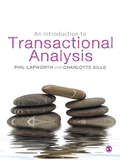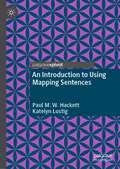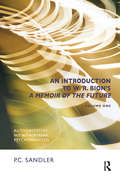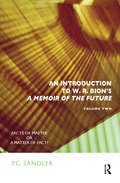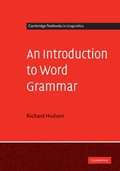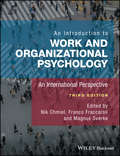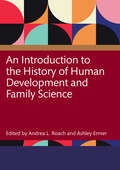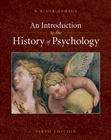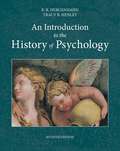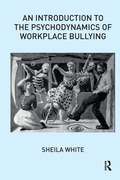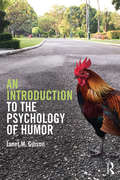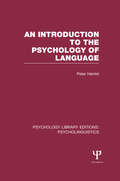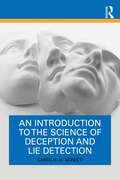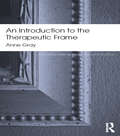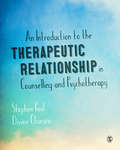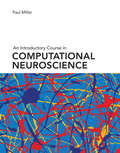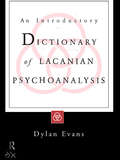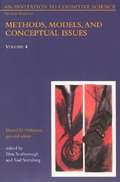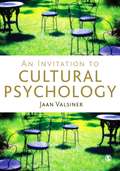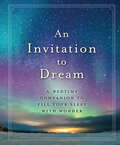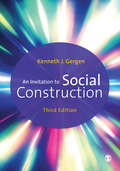- Table View
- List View
An Introduction to Transactional Analysis: Helping People Change
by Charlotte Sills Mr Phil LapworthThis thoroughly revised edition of Transactional Analysis Counselling introduces the theory and practice of TA - which integrates cognitive behavioural and psychodynamic theories within a humanistic philosophy - from a unique relational perspective. While most TA books focus on one field, this approach demonstrates the benefits of TA across a wide variety of helping settings, business and management, education and coaching as well as counselling. Case studies from a variety of contexts bring TA to life for trainees in any of these disciplines, and the accessible, engaging writing style makes difficult concepts understandable for undergraduates and postgraduates alike. Bringing their book into the twenty-first century, expert authors Phil Lapworth and Charlotte Sills provide a brief history of TA followed by individual chapters on the concepts and techniques used. Each chapter is devoted to one concept and includes a detailed definition and description, and suggestions for application in practice. Exercises for student, practitioner and client, boxed summaries, diagrams, checklists and sources of further reading make this the ideal text for use in training. This book is an essential companion for those embarking on specialist TA courses or studying TA as part of wider training, while those who want simply to integrate TA into their work with people can dip into it as suits their needs.
An Introduction to Using Mapping Sentences
by Paul M. Hackett Katelyn LustigThis book acts as an introductory guide to understanding and using the mapping sentence as a tool in social science and humanities research. The book fills the need for a concise text that simply instructs how and when to use a mapping sentence and provides practical examples. Mapping sentences are a major research component and tool of facet theory. The book begins by covering the background to mapping sentence, including the philosophy and theory underpinning it. The following chapter discuss what mapping sentence is, what different kinds of mapping sentences exist, and knowing when and which to use it in a given situation. The book then moves into describing how to write a mapping sentence and how to analyse the information gained from mapping sentence research. It ends with a consideration of the future developments of mapping sentences and their applications across the social sciences and humanities, including in particular psychology, marketing, behavioural biology, art and health.
An Introduction to W.R. Bion's 'A Memoir of the Future': Authoritative, Not Authoritarian, Psychoanalysis
by P.C. SandlerIn the last years of his life Bion gathered unusual manuscripts handwritten in his tidy lettering that assumed the form of a trilogy. Finely typed and edited by his dedicated wife, they were named A Memoir of the Future. Many of the themes of this book were already evident in Transformations and Attention and Interpretation. These earlier books provide many of the theories whose practical counterpart finally found a form in the trilogy: as Bion himself noted, "the criteria for a psychoanalytic paper are that it should stimulate in the reader the emotional experience that the writer intends, that its power to stimulate should be durable, and that the emotional experience thus stimulated should be an accurate representation of the psychoanalytic experience that stimulated the writer in first place." Was Bion true to his word? It is perhaps left to the reader to answer this question. The present book is an attempt to indicate the view that Bion's attempt was to present the burning flame itself - rather than presenting static photographs of the fire.
An Introduction to W.R. Bion's 'A Memoir of the Future': Facts of Matter or a Matter of Fact?
by P.C. SandlerIn the last years of his life Bion gathered unusual manuscripts handwritten in his tidy lettering that assumed the form of a trilogy. Finely typed and edited by his dedicated wife, they were named A Memoir of the Future. Many of the themes of this book were already evident in Transformations and Attention and Interpretation. These earlier books provide many of the theories whose practical counterpart finally found a form in the trilogy: as Bion himself noted, "the criteria for a psychoanalytic paper are that it should stimulate in the reader the emotional experience that the writer intends, that its power to stimulate should be durable, and that the emotional experience thus stimulated should be an accurate representation of the psychoanalytic experience that stimulated the writer in first place." In this second volume of a much needed introduction to Bion's last work, A Memoir of the Future, Paulo Cesar Sandler continues his detailed and insightful "prelude" to a work many readers have found "obscure, complicated and difficult".
An Introduction to Word Grammar
by Richard HudsonWord grammar is a theory of language structure and is based on the assumption that language, and indeed the whole of knowledge, is a network, and that virtually all of knowledge is learned. It combines the psychological insights of cognitive linguistics with the rigour of more formal theories. This textbook spans a broad range of topics from prototypes, activation and default inheritance to the details of syntactic, morphological and semantic structure. It introduces elementary ideas from cognitive science and uses them to explain the structure of language including a survey of English grammar.
An Introduction to Work and Organizational Psychology: An International Perspective
by Franco Fraccaroli Magnus Sverke Nik ChmielThis fully updated edition of a best-selling textbook provides the most comprehensive introduction to issues in work and organizational psychology with an international perspective; reflecting current advancements in the workplace, the book brings together the expertise of leading thinkers and practitioners. Fully updated third edition of the best-selling textbook on work and organizational psychology now with an international perspective Presents a solid foundation on a range of core topics including working with technology, the impact on employees when organizations change, and maintaining the work-life balance Updated throughout to include recently emerging themes and current views in the field Includes five new case studies covering age management, diversity at the top, resilience development, respect at work and a strategic approach to improving wellbeing in the workplace Provides instructor and student support includes key studies, research close-ups, discussion points and five extensive case studies
An Introduction to the History of Human Development and Family Science
by Andrea L. RoachThis comprehensive textbook offers an interdisciplinary introduction to the history of human development and family science. It provides insights from home economics, sociology and psychology to explain and analyze how the field was established and how it is developing and showcases the contribution of its unique transdisciplinary nature.Expert authors cover key topics and highlight historical contributions from women, scholars of color and LGBTQIA scholars; they emphasize and incorporate research that cuts across cultures; and examine current human development and family science trends in research and careers in their chosen fields. Subjects and issues covered include historical and contemporary studies of child development, adolescent development and young adulthood, adulthood and aging, family science, marriage formation and maintenance, parenthood, divorce, the role of grandparents and sibling relationships.Exploring how human development and family science can be used as a springboard into careers such as marriage and family therapy, social work, case management, teaching and research, this essential textbook is for all students of human development and family science.
An Introduction to the History of Psychology
by B. R. HergenhahnThis textbook traces the history of psychology from the ancient Greeks to the present, with chapters discussing the major schools of thought, important developments, and the contributions of particular theorists. Among those discussed are Aristotle, empiricism and positivism, rationalism, romanticism and existentialism, the rise of experimental psychology, the rise of mental testing, functionalism, behaviorism, Gestalt psychology, psychoanalysis, humanistic psychology, psychobiology, and cognitive psychology. Hergenhahn taught at Hamline University. Annotation ©2004 Book News, Inc., Portland, OR (booknews.com)
An Introduction to the History of Psychology
by B. R. Hergenhahn Tracy HenleyDreams puzzled early man, Greek philosophers spun elaborate theories to explain human memory and perception, Descartes postulated that the brain was filled with "animal spirits," and psychology was officially deemed a "science" in the 19th century. In this Seventh Edition of AN INTRODUCTION TO THE HISTORY OF PSYCHOLOGY, authors Hergenhahn and Henley demonstrate that most of the concerns of contemporary psychologists are manifestations of themes that have been part of psychology for hundreds--or even thousands--of years. The book's numerous photographs and pedagogical devices, along with its biographical material on key figures in psychology, engage readers and facilitate their understanding of each chapter. Available with InfoTrac Student Collections http://gocengage. com/infotrac.
An Introduction to the Philosophy of Psychology
by Fred Adams Daniel A. WeiskopfPsychology aims to give us a scientific account of how the mind works. But what does it mean to have a science of the mental, and what sort of picture of the mind emerges from our best psychological theories? This book addresses these philosophical puzzles in a way that is accessible to readers with little or no background in psychology or neuroscience. Using clear and detailed case studies and drawing on up-to-date empirical research, it examines perception and action, the link between attention and consciousness, the modularity of mind, how we understand other minds, and the influence of language on thought, as well as the relationship between mind, brain, body, and world. The result is an integrated and comprehensive overview of much of the architecture of the mind, which will be valuable for both students and specialists in philosophy, psychology, and cognitive science.
An Introduction to the Psychodynamics of Workplace Bullying
by Sheila WhiteThis book gives in-depth insights into the core issues of workplace bullying from the perspectives of the individuals involved, their interpersonal relationships, the group dynamics and organisational contexts. Workplace bullying is costly: increasingly petty conflicts are being registered as formal complaints and, in no time, legalities take over and costs spiral out of control. Preventive actions and interventions need to be based on a sound knowledge of the deeper issues which foster bullying scenarios. This book gets to the roots of why and how bullying occurs. Four main chapters are devoted to individuals, interpersonal relationships, group dynamics, and organisational contexts. The fifth chapter is a case study of the 'turn round' of a workplace in which bullying was rife. There are three recurring themes: recognition, loss, and space. New ways of conceptualising bullying are presented from drawing on the literature on the subject, as well as a range of psychodynamics theories. Bullying is described as a perverse and pernicious form of projective identification, occurring around organisational vacuums and structural fractures.
An Introduction to the Psychology of Humor
by Janet M. GibsonAn Introduction to the Psychology of Humor provides a comprehensive and accessible overview of psychologists’ research on humor. Drawing on research from a variety of psychological perspectives, from cognitive and biological to social and developmental, the book explores factors that affect our detection, comprehension, liking, and use of humor. Throughout the book, theories and paradigms of humor are explored, with each chapter dedicated to a distinct field of psychological research. Covering topics including humor development in children and older adults, humor’s effectiveness in advertisements, cross-cultural psychology and humor’s functions in the workplace, the book addresses the challenges psychologists face in defining and studying humor despite it being a universal and often daily experience. Featuring a wealth of student-friendly features, including learning objectives and classroom activities, An Introduction to the Psychology of Humor is an essential read for all students of humor.
An Introduction to the Psychology of Language (Psychology Library Editions: Psycholinguistics)
by Peter HerriotOriginally published in 1970, this was Peter Herriot’s first book. In this objective, critical evaluation of a rapidly expanding field, Professor Herriot examines language as skilled behaviour, generative linguistics and psychology, behaviourist approaches to meaning, language acquisition and impairment, and language and thought. He stresses throughout the necessity for empirical research and for experimental verification of hypotheses; he also feels that language behaviour should be analysed in a comprehensive form, placing emphasis not only on structural aspects but also on the importance of meaning and context to any account of language. Today it can be read and enjoyed in its historical context.
An Introduction to the Science of Deception and Lie Detection
by Chris N. StreetThis accessible book provides a foundational understanding of the science of deception and lie detection. Focusing on core issues for the field, it discusses classic and current psychological research into lying as well as theoretical approaches to understanding human lie detection. This book explores engaging questions around how people lie, how people make decisions about believing others, and how we can detect deception. Each chapter is clearly structured to support students of all levels by summarising content, presenting key research, and systematically evaluating findings. Chapters explore topics including some of the most promising current lie detection techniques, how and why people lie, how lying develops in children, and whether unconscious thinking can boost lie detection accuracy. Providing an overview of key issues in deception, this book will be of great interest to students and lecturers in the field of deception and lie detection, as well as anyone generally interested in this fascinating field of research.
An Introduction to the Therapeutic Frame: Routledge Mental Health Classic Editions (Routledge Mental Health Classic Editions)
by Anne GrayDesigned for psychotherapists and counsellors in training, An Introduction to the Therapeutic Frame clarifies the concept of the frame - the way of working set out in the first meeting between therapist and client. This Classic Edition of the book includes a brand new introduction by the author. Anne Gray, an experienced psychotherapist and teacher, uses lively and extensive case material to show how the frame can both contain feelings and further understanding within the therapeutic relationship. She takes the reader through each stage of therapeutic work, from the first meeting to the final contact, and looks at those aspects of management that beginners often find difficult, such as fee payment, letters and telephone calls, supervision and evaluation. Her practical advice on how to handle these situations will be invaluable to trainees as well as to those involved in their training.
An Introduction to the Therapeutic Relationship in Counselling and Psychotherapy
by Stephen Paul Divine CharuraThe therapeutic relationship is considered to be the most significant factor in achieving positive therapeutic change. As such, it is essential that trainee and practising therapists are able to facilitate a strong working alliance with each of their clients. This book will help them do just that, by offering a practical and evidence-based guide to all aspects of the therapeutic relationship in counselling and psychotherapy. Cross-modal in its approach, this book examines the issues impacting on the therapeutic relationship true to all models of practice. Content covered includes: - The history of the therapeutic relationship - The place of the therapeutic relationship in a range of therapy settings, including IAPT - Concepts and practical skills essential for establishing and maintaining a successful working alliance - The application of the therapeutic relationship to a variety of professional roles in health and social care - Practice issues including potential challenges to the therapeutic relationship, working with diversity and personal and professional development - Research and new developments Using examples, points for reflection and chapter aims and summaries to help consolidate learning, the authors break down the complex and often daunting topic of the therapeutic relationship, making this essential reading for trainee and practising therapists, as well as those working in a wider range of health, social care and helping relationships.
An Introduction to the Therapeutic Relationship in Counselling and Psychotherapy
by Stephen Paul Divine CharuraThe therapeutic relationship is considered to be the most significant factor in achieving positive therapeutic change. As such, it is essential that trainee and practising therapists are able to facilitate a strong working alliance with each of their clients. This book will help them do just that, by offering a practical and evidence-based guide to all aspects of the therapeutic relationship in counselling and psychotherapy. Cross-modal in its approach, this book examines the issues impacting on the therapeutic relationship true to all models of practice. Content covered includes: - The history of the therapeutic relationship - The place of the therapeutic relationship in a range of therapy settings, including IAPT - Concepts and practical skills essential for establishing and maintaining a successful working alliance - The application of the therapeutic relationship to a variety of professional roles in health and social care - Practice issues including potential challenges to the therapeutic relationship, working with diversity and personal and professional development - Research and new developments Using examples, points for reflection and chapter aims and summaries to help consolidate learning, the authors break down the complex and often daunting topic of the therapeutic relationship, making this essential reading for trainee and practising therapists, as well as those working in a wider range of health, social care and helping relationships.
An Introductory Course in Computational Neuroscience (Computational Neuroscience Series)
by Paul MillerA textbook for students with limited background in mathematics and computer coding, emphasizing computer tutorials that guide readers in producing models of neural behavior. This introductory text teaches students to understand, simulate, and analyze the complex behaviors of individual neurons and brain circuits. It is built around computer tutorials that guide students in producing models of neural behavior, with the associated Matlab code freely available online. From these models students learn how individual neurons function and how, when connected, neurons cooperate in a circuit. The book demonstrates through simulated models how oscillations, multistability, post-stimulus rebounds, and chaos can arise within either single neurons or circuits, and it explores their roles in the brain. The book first presents essential background in neuroscience, physics, mathematics, and Matlab, with explanations illustrated by many example problems. Subsequent chapters cover the neuron and spike production; single spike trains and the underlying cognitive processes; conductance-based models; the simulation of synaptic connections; firing-rate models of large-scale circuit operation; dynamical systems and their components; synaptic plasticity; and techniques for analysis of neuron population datasets, including principal components analysis, hidden Markov modeling, and Bayesian decoding. Accessible to undergraduates in life sciences with limited background in mathematics and computer coding, the book can be used in a “flipped” or “inverted” teaching approach, with class time devoted to hands-on work on the computer tutorials. It can also be a resource for graduate students in the life sciences who wish to gain computing skills and a deeper knowledge of neural function and neural circuits.
An Introductory Dictionary of Lacanian Psychoanalysis
by Dylan EvansJacques Lacan's thinking revolutionised the theory and practice of psychoanalysis and had a major impact in fields as diverse as film studies, literary criticism, feminist theory and philosophy. Yet his writings are notorious for their complexity and idiosyncratic style. Emphasising the clinical basis of Lacan's work, An Introductory Dictionary of Lacanian Psychoanalysis is an ideal companion to his ideas for readers in every discipline where his influence is felt. The Dictionary features:* over 200 entries, explaining Lacan's own terminology and his use of common psychoanalytic expressions* details of the historical and institutional context of Lacan's work* reference to the origins of major concepts in the work of Freud, Saussure, Hegel and other key thinkers* a chronology of Lacan's life and works.
An Invitation to Cognitive Science, Volume 4 (2nd edition)
by Daniel N. OshersonThe 4th volume of the series, which covers Methods, Models, and Conceptual Issues.
An Invitation to Cognitive Science, Volumes 1-3 (2nd edition)
by Edward E. Smith Daniel N. OshersonThe first three volumes of a four-volume introduction to contemporary cognitive science. The volumes are self-contained, and can be used individually in a variety of advanced undergraduate and graduate courses.
An Invitation to Cultural Psychology
by Jaan ValsinerAn Invitation to Cultural Psychology looks at the everyday life worlds of human beings through the lens of a new synthetic perspective in cultural psychology - that of semiotic dynamics. Based on historical work from many different fields in the social and behavioural sciences, and the humanities too, this perspective applied to cultural psychology suggests that human beings are constantly creating, maintaining and abandoning hierarchies of meanings within all cultural contexts they experience. It's a perspective that leans heavily on the work of the great French philosopher, Henri Bergson, only now being realised as a core basis for human cultural living. Jaan Valsiner is the founding editor of the major journal in the field, Culture & Psychology, and Editor of the Oxford Handbook of Culture and Psychology. He is the first Niels Bohr Professor of Cultural Psychology at Aalborg University in Denmark, where he leads Europe's first Research Centre on Cultural Psychology.
An Invitation to Cultural Psychology
by Professor Jaan ValsinerInstructors - Electronic inspection copies are available or contact your local sales representative for an inspection copy of the print version. An Invitation to Cultural Psychology looks at the everyday life worlds of human beings through the lens of a new synthetic perspective in cultural psychology – that of semiotic dynamics. Based on historical work from many different fields in the social and behavioural sciences, and the humanities too, this perspective applied to cultural psychology suggests that human beings are constantly creating, maintaining and abandoning hierarchies of meanings within all cultural contexts they experience. It’s a perspective that leans heavily on the work of the great French philosopher, Henri Bergson, only now being realised as a core basis for human cultural living. Jaan Valsiner is the founding editor of the major journal in the field, Culture & Psychology, and Editor of the Oxford Handbook of Culture and Psychology. He is the first Niels Bohr Professor of Cultural Psychology at Aalborg University in Denmark, where he leads Europe's first Research Centre on Cultural Psychology.
An Invitation to Dream: A Bedtime Companion to Fill Your Sleep with Wonder
by Workman PublishingSweet Dreams Leave the busyness of the day behind and enter a world of enchantment. Pairing words from poets and writers with lush, romantic images—dusky forests and fresh-fallen snow, secret paths and rainy nights—every page of this soothing bedside companion is designed to put mind and body at ease before sleep, while inspiring the imagination to reflect, to discover, to wander, to dream.
An Invitation to Social Construction
by Kenneth J. GergenThis new edition of Kenneth J. Gergen’s celebrated text An Invitation to Social Construction is now even more accessible for students, offering a clear and thorough introduction to one of the most significant movements in contemporary social science. The Third Edition includes: updates reflecting the many new developments in theory, research, and practice a more student-friendly, personal writing style three new chapters on education, and therapy and health care, and organizations key insights into how social construction can help support you in your research projects, from start to finish. An Invitation to Social Construction is the must-read text for all social science students, academics and practitioners wishing to learn about social constructionism, along with the forms of inquiry and practice central to its impact.
